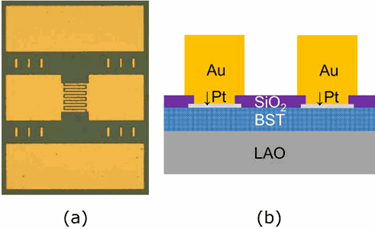Tunable RF Devices Made Of Barium Strontium Titanate Adapt To Changing Environments
By Jof Enriquez,
Follow me on Twitter @jofenriq

Researchers at University of California, Santa Barbara (UCSB), have successfully devised a way to fabricate tunable, high-frequency integrated circuits and RF devices that adapt to changing environments using a novel material called barium strontium titanate (BST).
One property of this material — an inherently large dielectric constant that can be altered significantly by an applied electrical field up to a factor of ten — has been known for more than half a century. Such materials, capable of being altered or reconfigured electronically, show enormous potential for adaptive or reconfigurable electronic systems – particularly high-frequency communications.
Historically, though, engineers have not been able to exploit this property because the inherently high capacitance density of barium strontium titanate "requires smaller electrode dimensions and finer lithography than many typical integrated capacitor structures,” said Robert York, a professor in the Electrical & Computer Engineering department at UCSB, in a news release. "Low-loss reactive devices also pose significant measurement challenges at microwave frequencies."
Now, to finally exploit this material's "tenability," the UCSB team has successfully developed a new fabrication method using a combination of high-quality, epitaxial, stoichiometric BST films, as afforded by hybrid molecular beam epitaxy (MBE), and high-quality electrode interfaces, which avoid non-tunable interface layers.
York and colleagues explained further in the abstract of their paper published in Applied Physics Letters, "The fabrication, measurement, and modeling of radio-frequency (RF), tunable interdigital capacitors (IDCs) are described. High quality factors of 200 in the S/L-bands combined with a 47% tunability are achieved by utilizing epitaxial (Ba,Sr)TiO3 films grown by hybrid molecular beam epitaxy on LaAlO3 substrates. The fabricated devices consisted of one-port and two-port IDCs embedded in ground-signal-ground, coplanar waveguide transmission lines to enable RF probing. Wideband RF scattering parameters under bias were measured from 100 MHz to 40 GHz. A commutation quality factor averaging 6000 across the L band is achieved. These are the highest reported values in this band."
“Our work also demonstrates that with suitable modifications, MBE systems – a proven technology for large-scale manufacturing of compound semiconductor materials – can be used to deposit a wide variety of high-quality materials,” Susanne Stemmer, a professor at the Materials Research Laboratory at UCSB, said in the news release.
The researchers attribute the low-quality performance of past barium strontium titanate-based devices to deposition and processing methods, and to contamination from other organic materials commonly used in photolithography processes, and not on its intrinsic properties.
The UCSB team intends to further improve the processing and device design, and to “demonstrate high-performance integrated circuits with films deposited directly on metal electrodes,” Stemmer said. “Integration with other commercially viable substrate materials is also of interest.”
A fully-realized barium strontium titanate tunable capacitor can have many applications in high-frequency communications.
“For example, tunable capacitors using barium strontium titanate can be used to create tunable antennas for cellular communications, which allows a small antenna to be tuned over a wide frequency range or enables a phone to adapt to different surroundings for improved efficiency and battery life,” said York.
These BST-based devices also could be used to create low-cost phase-shifter devices for phased-array antennas in mobile satellite communication systems.
According to the National Institute of Standards and Technology (NIST), tunable dielectric materials like strontium oxide stacked in multilayer crystals could enable a whole new class of compact, high-performance, high-efficiency components for devices such as cellular phones. Integrating oxides with silicon chips could pave the way for new “smart” devices, as well.
